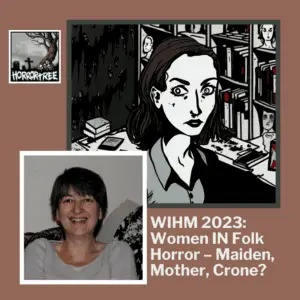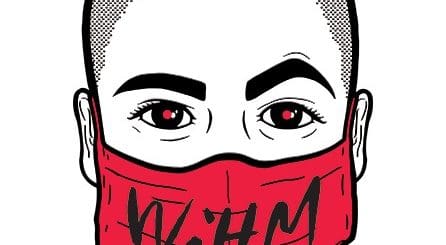WIHM 2023: Women IN Folk Horror – Maiden, Mother, Crone?

Women IN Folk Horror – Maiden, Mother, Crone?
By Stephanie Ellis
As a writer of folk horror, I have created my own unique world within the Five Turns novels (The Five Turns of the Wheel and Reborn) in which human and semi-human/supernatural creatures interact according to old beliefs and religion. Within this particular community, I have deliberately placed The Mother—Mother Nature—at the top of the pecking order; all worship her, but the males of her family subvert her rule. There is very definitely an ongoing conflict as to who, ultimately, wields power in this world. The religion, the rituals, the contract between people and the goddess of the land, of blood and sacrifice in return for prosperity is a link that has been found again and again throughout the history of humanity. And again and again, the woman has been used as that physical representation within folk horror: the fertility of woman equates to the fertility of the land. But gives her no agency of her own. Once those so-called fertile years end, the woman is dismissed, becomes Crone, a horrible name with its connotation of old equalling ugly. But is that just an impression gleaned from watching a few films, reading a few books, or does it remain a trend?
I called this article, ‘Women IN Folk Horror – Maiden, Mother, Crone?’, the capitalisation of IN referring to how women are portrayed within folk horror literature*. It is something I have long pondered: how the female has been used to set up the backdrop of the story. What is her underlying role?
I wanted to see if those background or more secondary characters were fulfilling the usual fertility cult or witchcraft aspect so I carried out a mini-survey of a random selection of novels and short stories found on my shelves.
| Book | Year | Female Characters | Purpose |
| The Wicker Man, Robin Hardy & Anthony Shaffer | 1978 | Willow – Landlord’s Daughter. | Explicit representation of fertility cult, manipulated by Lord Summerisle to ensure harvest. |
| Blood on Satan’s Claw, Robert Wynne Simmons | 2022
(film 1971) |
Angel Blake. | Witch/demonic possession. Leads the horrors at demon’s behest. |
| Harvest Home, Thomas Tryon | 1973 | Widow Fortune
Beth Constantine |
Leads worship of the Earth Goddess, Mother Earth.
Becomes Corn Maiden in harvest ritual. |
| The Ceremonies, T.E.D. Klein | 1984 | Carol Conklin
Mrs Poroth |
Manipulated so body can host demon birth.
Occult power |
| Water Shall Refuse Them, Lucie McKnight Hardy | 2019 | Janet | Witchcraft |
| Lure, Tim McGregor | 2019 | Agnet (& others) | In thrall to mermaid/perform ritual – for the preferment of the female in this instance. |
| The Ritual, Adam Nevill | 2011 | Old woman | Performing the summoning rite |
| In the Grimdark Strands of the Spinnaret, Keith Anthony Baird | Crone in woods | Witch who facilitates the horrors | |
| Song of the Red Squire, C.W. Blackwell | 2022 | Cal | Sacrifice to secure fruit harvest. |
| ‘Sire of the Hatchet’,
‘An Encounter in 1690’, (Grimoire of the Four Imposters), Coy Hall |
2021 | Rosamund
Lady Hyacinth Willoughby |
Implication of witchcraft
Witchcraft |
| ‘The Fruit’, Lindsay King-Miller, The Fiends in the Furrows | 2018 | Women of the village in general | Victims of orchard, becoming mothers. |
| The Man in the Field, James Cooper | 2022 | Women in the village of a cult | Valued for reproductive capacity |
I have a number of other books and anthologies, but for the sake of brevity, this will do. In the stories listed above, it becomes clear that the role of women in the background of a book or as a secondary character is to fill that long-held view of woman as witch or mother or future mother. Within the earlier books, it appears the women are much more passive, they are directed through the pages by a male protagonist, manipulated towards an end that is to the benefit of the community or the demonic force which holds sway (Blood on Satan’s Claw, The Wicker Man, The Ceremonies). Harvest Home differs in that it is the women who hold the power but again, this is in relation to fertility and harvest—very much a pervasive theme within folk horror books. My own Five Turns of the Wheel specifically treats these different ages of women to ritual, and they bear the brunt of suffering unfairly in comparison to the men, a treatment which is then challenged by the women themselves. Lure by Tim McGregor offers a fresh-take on the usual tropes by giving the women the upper-hand, but only because they are in thrall to a supernatural ‘luremaid’ of the sea rather than through any inherent power of their own. Women still need an external force to break free of a patriarchy.
Women are still very much Maiden, Mother, Crone, terms which link in to their reproductive ability and hence their value in terms of usefulness to a community. When women progress to the age of ‘crone’, they can be witch and banished from thought, or be the old woman of the village and rendered invisible, unvalued. In comparison, you find no, or very rare mention, of a male witch amongst such tales.
There is nothing wrong with using these tropes. I love folk horror in all its guises, and such treatments always help to serve up wonderful stories, but my thinking is that now it is time to bring folk horror into a new age with a greater value placed on the ‘crone’. One of the reasons Harvest Home is an absolute favourite is that not only does it subvert the pastoral idyll but ultimately shows that it is the women in charge (even though, again, the cult is linked to agricultural prosperity). For once, they are not sacrificed or treated as chattels; the tables are brilliantly turned.
Older women have served their communities already in their maternal role. When that is past, they have years of wisdom and experience to share rather than be shunned (The Man in the Field has a very strong older female protagonist, but again she is fighting against the traditional male hierarchy). And this is truly an age to explore and celebrate in folk horror. Bring in the older women with their wisdom, their moods, and yes, their cruelties! Invert the patriarchal agrarian cults, strip away the worship of youth, of beauty. The word ‘crone’ is so entrenched in minds as meaning an ugly old woman, that it needs to be reclaimed, understood once more in its more original form incorporating wisdom as well as age. The landscape is always a character in the pages of folk horror, but does the story have to link to agricultural prosperity? Could the rituals, the bond between the people and the land, be forged through the need for shelter, for the growth of woods, for water? All major concerns of society today and which I hope to touch on in some way in my new Five Turns novel (set in the blizzards of winter, with power/fuel gone due to shortage and strikes, what could possibly go wrong when my ‘folk’ appear?) There are so many ways to write folk horror that can move away from the stereotypes and give it fresh life and, in doing so, move a woman away from being defined by her womb!
Ultimately though, I would say however you like to read or write your folk horror, whether using traditional tropes or exploring new avenues, enjoy it. It is such a great sub-genre to have fun with, and I would truly recommend to everybody.
*My focus here is on the biology of woman in the scientific sense, their fertility and reproductive cycle and capacity to give birth, being intrinsic to their importance within folk horror ritual and storyline. And I use the terms woman, female interchangeably within this context and within the books I have examined.
- About the Author
- Latest Posts
Stephanie Ellis writes dark speculative prose and poetry and has been published in a variety of magazines and anthologies. Her longer work includes the folk horror novels, The Five Turns of the Wheel, Reborn, and The Woodcutter, and the post-apocalyptic/horror/sci-fi The Barricade, and the novellas, Bottled and Paused. Her dark poetry has been published in her collections Lilith Rising (co-authored with Shane Douglas Keene), Foundlings (co-authored with Cindy O’Quinn) and Metallurgy, as well as the HWA Poetry Showcase Volumes VI, VII, VIII, and IX and Black Spot Books Under Her Skin. She can be found supporting indie authors at HorrorTree.com via the weekly Indie Bookshelf Releases. She can be found at https://stephanieellis.org and on Blue Sky as stephellis.bsky.social.













